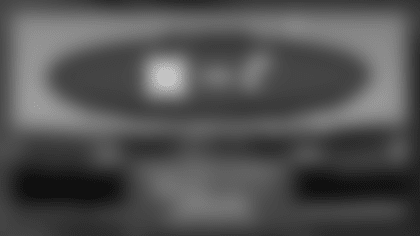The Kansas City Chiefs are preparing for their first draft under general manager Brett Veach, who took over the position last summer.
Veach, who began his career in Philadelphia with head coach Andy Reid back in 2007, spent the previous two years as the Chiefs' Co-Director of Player Personnel (2015-16) and served as the Pro and College Personnel Analyst (2013-14) before that.
"To have the whole team show up…to make us great." pic.twitter.com/2wbYiaWTkp — Kansas City Chiefs (@Chiefs) April 24, 2018
Earlier this week, we caught up with Veach and five members of his personnel department to talk about their process leading up to the draft.
In addition to Veach, we spoke with Chiefs' Director of Player Personnel Tim Terry, who has been with the Chiefs about a year after coming over from the Green Bay Packers, and also three area scouts in Willie Davis, Pat Sperduto, and Terry Delp.
Here's a look at those interviews:
Brett Veach – General Manager
Reaction to 2018 schedule:
"It's difficult. I think it's always funny because you hear a lot of analysis on the schedule on where it's easy, and where it's hard. I know one thing—that every game that you play in this league is a tough game. There's no easy game. It'll be a tough grind."
I asked #Chiefs GM Brett Veach what the chances are that they end up drafting eight players with the eight picks they currently have. pic.twitter.com/AEeibRhumc — BJ Kissel (@ChiefsReporter) April 25, 2018
What's the draft process been like so far?
"It's certainly a grind, and really when you think about it from the time we get to St. Joseph, Missouri (site of Chiefs' training camp) up until the day of the draft, there's probably not a day that goes by that a college player isn't evaluated. So, we get an original list back in June or July from the National Scouting Service, and we divvy up the schools and the players amongst our staff, and again, once we get to camp, we're starting to the watch tape, and we're gathering information."
On if he's ever content with the roster:
"I don't think you can ever be content because again injuries are part of this game. It's not a matter of if, but when, and you know it's going to happen, so you have to make sure there's competition for the starting positions, but you also have to make sure there's competition for sixth, seventh linemen, and for the backup running back and tight end positions. You've got to build depth, and you do that through competition."
On draft board right now:
"I think you start with 400-500 players. I think by this stage of the process we're down to 160-170, so we're crossing T's, dotting I's. And in regards to this draft class, I think all draft classes are unique in regards to where the strengths and weaknesses are, but I think our staff has done a great job of identifying those pockets and where we need to be aggressive and where we need to potentially trade down and acquire more picks."
On balancing attacking needs vs. taking the best player available:
"It's certainly a balancing act, but I think the overall philosophy every draft is to add talent, create competition, and just build depth. And I think that we don't have a first-round pick, but having a second, two threes and two fours that will give us all ammo we need to do just that."
Asked #Chiefs GM Brett Veach what's going through his mind when the draft begins on Thursday. pic.twitter.com/YtsU9ldQbv — BJ Kissel (@ChiefsReporter) April 24, 2018
How much he's looking forward to his first draft:
"It's going to be a lot of fun. I think going back to the player, the prospect, their family, it's a life-changing moment for them and to be a part of that is something special, and again, to bring players that will come in here and hopefully help us compete for a championship."
Tim Terry - Director of Pro Personnel
On his role:
"It entails dealing with the pro prospects, the advanced scouting, getting our coaches prepared for the personnel that will be playing the upcoming weeks, so scheme and all those things. Also, the recruiting of street free agents, college free agents, guys that might be in different leagues whether it be CFL, AFL, spring league, different prospects, and just having a good pulse for who's around in case we have an injury to keep our roster healthy.
"A lot of times you wouldn't know if position player A gets hurt, you have to have three or four guys ready to go that you can consider helping, so you don't have a big drop off. Throughout the year we'll work guys out, not for right now to sign a guy, but guys we might have interest in that might be still on the street—just in case we have an injury we can bring a guy in that we feel comfortable with picking up our scheme and not let the torch drop."
"It's infectious. It makes you want to pick your game up."
- Director of Pro Personnel Tim Terry talks about working with Brett Veach, and also his first year with the #Chiefs. pic.twitter.com/UDQpCOcRPM — BJ Kissel (@ChiefsReporter) April 25, 2018
How much of the evaluation is it about their character, what makes them tick?
"That's huge. Character. The only difference from college to pro is that you go to college and some players are good, some players are not so good, and some players are really elite. Whereas here everyone is good, everyone has talent, so what's going to separate talent from talent if you're all on the same plane? You got to have that character; you got to have guys that really want to buy into what you're trying to do. Not everyone can play in Kansas City, and that's a known fact. Some people may be better off in different cities, so the character, who they are, what makes them tick and what makes them drive, do they love football and are they passionate about it? And that's what we're trying to bring to guys here, and I think we did a good job of that, so character is huge."
On what draft represents to team to building future:
"It's like putting seeds in for what your tomorrow is going to look like. You want to get quality players. Not every player is going to pan out to be a quality player, but you want to get more than not. You want to hit more than not, so it's just big on trying to get guys that believe, that are going to fit the vision that Coach Reid has set, that Brett [Veach] has set, for what we want to do and how we want to play the style of play we want to have."
Willie Davis – Area Scout (2005-18)
How has scouting changed over the years?
"The schemes that colleges run has changed to a more passing league now. When I came in, it was more running, so you had your big backs, you wanted big offensive line to get those lanes open. Now it's more of a passing league, smaller quicker backs, get out of back field, catch passes out of the back field, so I think the scheme has changed. You have to find players to fit now."
What's his mindset when he starts evaluating every year:
"It's a clean slate. I go in and I have to scout every position, every player, I have to give him his due, make sure I'm not being biased to anyone, not listening to what someone else is thinking about a player. So, you've got to go in with a clean slate, open mind, look at the player for who he is and how he plays and that's it. You have to do it yourself and evaluate them."
Terry Delp – Area Scout (2001-18)
*On what it's like working with Veach:
*
"I think every general manager has their own style, different ways of doing it. Veach has been great. It's more like just a scout; he's been on the road, he knows what it's like, easy to talk to, just sitting together watching film just scouting you know? He doesn't make it too complicated, but get the work done."
"You've got to find out what makes the kid tick, what motivates him."
- #Chiefs area scout Terry Delp explains process of evaluating prospects. pic.twitter.com/hl2n5h9gwT — BJ Kissel (@ChiefsReporter) April 25, 2018
On the percent of an evaluation that's not seen by the casual fan on YouTube:
"I'd say well over 50 percent is the kid over the ability. I mean you got to see what makes a kid tick. You're projecting a kid from college to getting fame and money and see how he handles all that, and so you got to see what kind of kid he is, what makes him tick, what motivates him, that's a big part of it. We got to be able to tell the coach this is the kind of kid you get; this is how you motivate him, this is how you handle him."
On life as an area scout:
"I think the biggest misconception about scouting is people ask you, 'Hey, did they draft your guy? And it's not my guy. It's our guy. We get together, I just kind of set the table this is the kind of kid he is, but we all watch him together. We all come together with an opinion. It's our guy, so you're excited when we get one of the guys we like, so that's what you get excited about."
Pat Sperduto - Area Scout (2009-18)
On how much figuring out what guys are about being a part of the evaluation:
"I have kids that play sports, and I tell them you are always being evaluated. You'd be surprised at some of the sources that we get and some of the people that we talk to. We want to know everybody that's interacted with a guy, not just the coach. Obviously, as a coach, you always love all your players, so it's real hard to get negative or something that needs to set off an alarm in your head, so you have to look everywhere in the building so your sources expand—the tentacles go out everywhere. You're always being evaluated, so you've just got to be prepared."
Here's a small glimpse of what the dynamic is like between some of the #Chiefs scouts.
I asked Pat Sperduto what's the toughest position for him to evaluate.
Former #Chiefs WR Willie Davis (also a scout) took issue with his answer. pic.twitter.com/nrAtQ4Ihv0 — BJ Kissel (@ChiefsReporter) April 25, 2018
On the process of evaluating a player:
"You start with the athlete. You looking at the character is critical, but when you're starting to evaluate the player, you start with the athlete. What type of athlete is he? How does he move? How does he control his body? Does he have speed? Does he have quickness? Does he have balance? Does he have contact balance? Is he strong? Does he have power through his hips? Things like that. So you start with that, and once you have that basis, you try to get an understanding of okay, how does he fit us? What are the things that he can do for us? And what are the things he's going to struggle a little bit with us? That's really…you start with the athlete first."
"You've got to find out what's the best way for that guy to learn, to understand...what's the best way for that guy to retain."
- #Chiefs area scout Pat Sperduto explains relationship & dynamic with college coaches & evaluating players. pic.twitter.com/Y8wvHWCbRa — BJ Kissel (@ChiefsReporter) April 24, 2018













